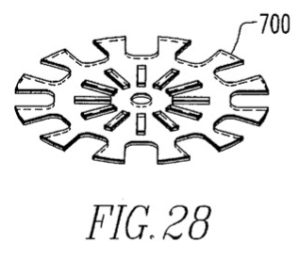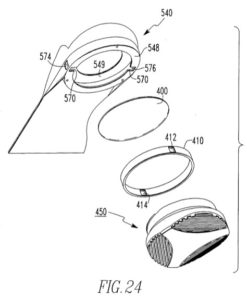By Garrett Fahy on June 21, 2021
Author: Garrett Fahy
Introduction
It is a question many intellectual property lawyers navigating a potential infringement case have undoubtedly pondered: how many communications with opposing counsel over a budding infringement dispute are enough to subject the attorney’s client to personal jurisdiction in the infringer’s home (and possibly foreign) forum? (And if they have not pondered it, they now have good reason to.)
In Trimble, Inc., Innovative Software Engineering, LLC v. Perdiemco LLC (2019-2164) (May 12, 2021), the Federal Circuit defined the number and type of communications and contacts that will subject a client to personal jurisdiction in a foreign and potentially inconvenient forum in a declaratory judgment patent infringement case: twenty-two communications in a three month period, even in service of potential settlement discussions, is enough to subject an attorney’s client to jurisdiction in a foreign forum if the court finds the communications constitute sufficient purposeful availment.
Background
Defendant PerDiemCo, LLC (“PerDiemCo”), a Texas LLC, is the owner of eleven patents (via assignment) having a common specification and relating to electronic logging devices and geofencing. Electronic logging devices log the hours and activities of truck and other commercial vehicle drivers to help their employers comply with federal and state safety regulations. PerDiemCo accused Trimble, Inc. (“Trimble”) and Innovative Software Engineering, LLC (“ISE”) of infringement in letters and other communications in the fall of 2018. Robert Babayi, a resident of Washington, D.C., is the sole owner, officer and employee of PerDiemCo, which rented office space in Marshall, Texas. Mr. Babayi had never visited the rental office in Marshall and had no employees in Marshall.
The declaratory judgment Plaintiffs, Trimble and its wholly owned subsidiary ISE, manufacture and sell positioning and navigation products and services that rely on the Global Positioning System (GPS). Trimble and ISE offer electronic logging devices and related services, and Trimble sells geofencing products. Trimble is incorporated in Delaware and headquartered in Sunnyvale, California (in the Northern District of CA). Trimble’s subsidiary, ISE, is an Iowa LLC with its headquarters and principal place of business in Coralville, Iowa.
Mr. Babayi of PerDiemCo launched the first communicative salvo in October of 2018, sending a letter to ISE in Iowa accusing ISE’s products and services of using technology covered by at least PerDiemCo’s electronic-logging-device patents. Mr. Babayi also attached to his letter a draft and unfiled complaint for the Northern District of Iowa which included a claim chart, proposed a license to PerDiemCo’s patents, and attached a draft non-disclosure agreement. In response to a letter from Trimble’s chief IP counsel, Mr. Babayi responded by alleging Trimble also infringed PerDiemCo’s patents and included a claim chart. Further calls followed and PerDiemCo then offered to enter into binding mediation.
In subsequent communications, PerDiemCo made additional allegations of infringement against Trimble concerning electronic logging devices, bringing the total number of asserted patents to eleven, and later alleged Trimble’s geofencing products infringed claims of six of the eleven already asserted patents that related to geofencing. In the course of these communications, PerDiemCo threatened to sue Trimble for patent infringement in the Eastern District of Texas and identified counsel it had retained for that purpose.
Plaintiffs’ Complaint for Declaratory Judgment of Non-Infringement
In January of 2019, Trimble and ISE filed a complaint for declaratory judgment of non-infringement in the Northern District of California, and alleged that PerDiemCo was subject to jurisdiction under a specific jurisdiction theory. PerDiemCo moved to dismiss, arguing the court lacked personal jurisdiction under Red Wing Shoe Co. v. Hockerson-Halberstadt, Inc., 148 F.3d 1355 (Fed. Cir. 1998). The district court held it lacked specific personal jurisdiction over PerDiemCo because even though Trimble had established PerDiemCo’s minimum contacts through its cease-and-desist letters and other communications that were purposefully directed at Trimble, a California resident, and Trimble’s declaratory judgment claim arose out of PerDiemCo’s activities, the court, applying Red Wing, held that exercising specific personal jurisdiction over PerDiemCo would be constitutionally unreasonable.
The Federal Circuit’s Opinion
The question for the Federal Circuit was whether Red Wing precluded the federal district court for the Northern District of California from asserting personal jurisdiction over PerDiemCo, based on its communications to Trimble. The court determined Red Wing does not preclude personal jurisdiction, and the district court had personal jurisdiction over PerDiemCo, a Texas LLC. Why?
First, the exercise of jurisdiction focuses on the “nature and extent of ‘the defendant’s relationship to the forum state,’” Ford Motor Co. v. Mont. Eighth Jud. Dist. Ct., 141 S. Ct. 1017, 1024 (2021) (“Ford”) (quoting Bristol-Myers Squibb Co. v. Superior Ct. of Cal., 137 S. Ct. 1773, 1779 (2017)), and the exercise of specific personal jurisdiction requires that the “plaintiff’s claims… ‘must arise out of or relate to the defendant’s contacts’ with the forum.” Id. The defendant must take some act by which it purposefully avails itself of the privilege of conducting activities within the forum state, and the contacts must show that the defendant deliberately reached out beyond its home. Id.
In Red Wing Shoe Co. v. Hockerson-Halberstadt, Inc., 148 F.3d 1355 (Fed. Cir. 1998), Hockerson-Halberstadt, Inc. (“HHI”) a Louisiana corporation with its principal place of business in New Mexico sent three demand letters in a three-month period to Red Wing Shoe Co., a Minnesota corporation with a principal place of business in Minnesota. Id. at 1357. HHI and Red Wing exchanged letters, in the course of which HHI made further allegations of infringement against Red Wing and offered Red Wing a nonexclusive license. Id. The court held HHI’s efforts were insufficient to constitute purposeful availment of the forum state on the grounds that a patentee should not subject itself to personal jurisdiction in a forum solely by informing a party who happens to be located there of suspected infringement, and basing personal jurisdiction on such contacts alone would not comport with principles of fairness. Id. at 1361. The court also said the cease-and-desist letter that included an offer of a license was more like an offer for settlement rather than an arms-length negotiation in anticipation of a long-term continuing business relationship. Id. And principles of fair play and substantial justice afforded a patentee sufficient latitude to inform others of its patent rights without subjecting itself to jurisdiction in a foreign forum. Id. at 1360-1361.
Post-Red Wing legal developments also set PerDiemCo’s actions apart from the plaintiff in Red Wing and rendered appropriate the district court’s exercise of jurisdiction over PerDiemCo.
First, the Supreme Court clarified in cases after Red Wing that the personal jurisdiction analysis in a patent case is not different on account of special patent policies. SCA Hygiene Prods. Aktiebolag v. First Quality Baby Prods., LLC, 137 S. Ct. 954, 964 (2017). In other words, there is no patent-specific statute for personal jurisdiction purposes. TC Heartland LLC v. Kraft Foods Grp., 137 S. Ct. 1514, 1518 (2017).
Second, the Supreme Court has held that communications sent into a state may create specific personal jurisdiction, depending on the nature and scope of such communications. South Dakota v. Wayfair, Inc., 138 S. Ct 2080 (2018). As the Court said in Quill Corp. v. North Dakota, 504 U.S. 298, 308 (1992), an entity that repeatedly sends communications into a forum state “clearly has ‘fair warning that its activities may subject it to the jurisdiction of a foreign sovereign.’” And the Federal Circuit has tracked this reasoning, finding that in the context of patent litigation, communications threatening suit or proposing settlement or patent licenses can be sufficient to establish personal jurisdiction. Jack Henry & Associates, Inc. v. Plano Encryption Technologies, LLC, 910 F.3d 1199 (Fed. Cir. 2018) (exercise of personal jurisdiction over a defendant was reasonable after the defendant sent communications to eleven banks located in the forum, identifying the patents, alleging the Banks were infringing the patents and inviting non-exclusive licenses.).
Third, the Court’s decision in Ford means that “a broad set” of a defendant’s contacts with a forum are relevant to the minimum contacts analysis. There, in deciding the question whether Montana’s and Minnesota’s courts could exercise personal jurisdiction over Ford for accidents involving Ford cars that took place in the states despite the vehicles not being sold in either state, the Court focused not on the contacts related to the specific vehicles, but Ford’s broader efforts to sell similar vehicles in each state. Ford’s “veritable truckload of contracts” with the states were relevant to analyzing the connection between Ford’s forum contacts and the plaintiff’s suit. Id. at 1031-32.
In short, while the “limited number of communications” in Red Wing—three—was not sufficient to constitute purposeful availment of the forum state, the Federal Circuit here found that twenty-two communications was more than sufficient in light of the nature of the communications, the expanding scope of the communications from ISE initially to later include Trimble and its alleged infringement, PerDiemCo’s retention and identification of counsel in Texas and its history of filing lawsuits all over the country, which was its core business effort. PerDiemCo “repeatedly contacted Trimble and ISE in California, accumulating an extensive number of contacts with the forum in a short period of time.”
The Federal Circuit found that PerDiemCo went far beyond informing plaintiffs of its patent rights without subjecting itself to jurisdiction, and its attempts to extract a license were more akin to an arms-length negotiation in anticipation of a longer term continuing business relationship, over which a district court may exercise jurisdiction. And, an obvious fact, Trimble was headquartered in California. Plaintiffs’ declaratory judgment action related to PerDiemCo’s contacts with California, and the minimum contacts or purposeful availment requirement was easily met here.
Finally, as to the five factors from Burger King Corp. v. Rudzewicz, 471 U.S. 462 (1985) and World-Wide Volkswagen Corp. v. Woodson, 444 U.S. 286 (1980) bearing on whether the exercise of personal jurisdiction would comport with fair play and substantial justice, the court found they all weighed in favor of exercising jurisdiction. First, as to the burden on the defendant, the court found given that PerDiemCo’s history of suing in Texas, threatening to sue in Iowa, its burden of litigating in California was only slightly greater than litigating in Texas or Iowa. Second, as to the forum state’s interest in adjudicating the dispute, the court found California and the Northern District had a significant interest as Trimble resides there. Third, as to plaintiffs’ interest in obtaining convenient and effective relief, Trimble had an interest in protecting itself from patent infringement by obtaining relief from a nearby federal court in its home forum, and Trimble’s employees and documents were located there. Fourth, as to the interstate judicial system’s interest in obtaining the most efficient resolution of controversies, that interest did not counsel against jurisdiction in California. Fifth and finally, as to the shared interest of the several states in furthering fundamental substantive social policies, the court found no conflict between the interests of California and any other state because the same body of patent law would apply regardless of the forum.
What It Means/Practice Pointers
In light of this recent decision, what is the message for IP attorneys practicing in this area? First, be mindful of the residency or principal place of business of the company you are accusing of infringement. A good question to ask before sending the third, fourth or fifth letter may be: does my client want to defend a lawsuit in ________ (home of alleged infringer)? Its home forum may soon be the forum for your client’s dispute, no matter how far it is from your client, or you. One practice pointer may be: do your research first and include every possible infringement allegation against the other company (or its parent or subsidiary entities) in one letter, rather than in an escalating series of letters addressing new/different allegations against different entities.
Conversely, if your client is being accused of infringement by a corporation and attorney from a foreign forum, keep up the contacts and communications and invite more – they may temporarily incur short-term costs but help your client keep a declaratory judgment case you file in its home forum, which could decrease long-term larger costs.
Second, if you are accusing a foreign corporation of infringement and repeatedly corresponding with that company’s counsel, be mindful that every aspect of your correspondence or matter handling, beyond the merits, will be scrutinized in the context of a personal jurisdiction analysis, and there is no trophy for most communications; there may be more travel costs.
Third, remember that escalations of the engagement beyond mere communications could amount to your client’s purposeful availment of the accused infringer’s forum. Thus, beyond letters, emails or phone calls, transmission of draft complaints, submission of potential license agreements, requests for mediation, and identification of counsel who will prosecute an infringement action are contacts courts will scrutinize in the context of the personal jurisdiction analysis. And courts may not look favorably on clients whose counsel increase the scope and scale of their accusations only to later claim an unbearable burden in litigating in the home forum of the accused party.
In short, what may be regarded as mere zealous or creative advocacy for a client could, absent any intention towards this end, land the client in a foreign forum. To borrow from the well-known phrase, the road to a foreign forum is paved with good intentions.
About the author: Garrett M. Fahy is Senior Counsel and a member of Gordon Rees Scully Mansukhani’s Intellectual Property Practice Group. He handles trademark, copyright, and patent litigation in a variety of commercial sectors and technologies.









